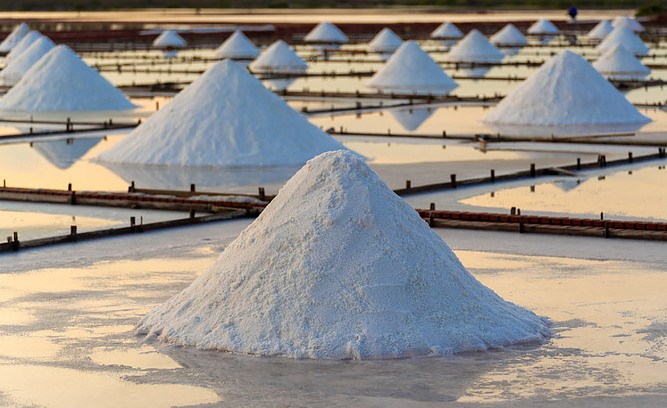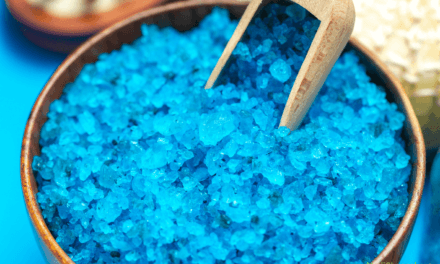Here we will be exploring the relationship between Celtic Sea Salt and diabetes to answer the question – Is Celtic Sea Salt Good for Diabetics? This guide is one personally very close to me, so our team dug into research evidence to come up with an ultimate guide for you.
Story Of A Trial With Celtic Sea Salt
When my mom was diagnosed with type 2 diabetes, I was determined to explore natural ways to enhance her diabetes management. Celtic Sea salt quickly caught my attention as a game-changer. We made the switch from regular table salt to Celtic Sea salt in our recipes, and the result was a burst of flavor that ignited our taste buds with joy.
Intrigued by its potential, we delved into research and discovered that Celtic Salt is like a hidden treasure with essential minerals like magnesium, potassium and calcium playing a vital role in overall health. It felt like unlocking a secret to better well-being.
As my mom continued using Celtic Sea salt, we observed positive changes in her diabetes management. Her blood sugar levels became more balanced, and her cravings for highly processed foods gradually reduced. It was as if Celtic Sea Salt possessed a magical power to transform our meals into satisfying and healthier options.
Buoyed by the positive impact on our family, we enthusiastically shared our newfound secret with others, and they too, experienced improvements in their health, spreading a message of hope and well-being.
Diabetes And Its Effects
Diabetes is a chronic condition that affects millions of people worldwide.
Studies show that in the US, about 1 in 10 have diabetes, and 1 in 5 don’t even know they have it, according to the US Centers for Disease Control and Prevention (CDC). Isn’t that astonishing?! That’s not it, it’s also responsible for 5% of blindness in the world.
Solutions For Diabetes
Managing diabetes involves careful attention to various aspects of lifestyle, including diet and nutrition. People with diabetes often seek substitutes for ordinary ingredients and natural options with potential benefits.
This is where salts such as Celtic Salt and Himalayan Salts come in. I have listed alternative salts you may try at the end of this article. And, this article is all about Celtic Sea Salt and Diabetes.
Let’s continue…
Exploring The Potential Benefits Of Celtic Salt
Celtic Salt has many benefits due to its unique and rich mineral composition, which may support cardiovascular health and diabetes management. However, moderation and an individualized approach are important to consider.
Now let’s take a closer look at Celtic Sea Salt and its relationship with diabetes, explore what Celtic sea salt is, and discuss its composition. To determine whether it will be beneficial for individuals with diabetes or not, our first aim should be to understand what Celtic Sea Salts are.
What is Celtic Sea Salt?
Celtic sea salt, also known as ‘Sel Gris’, which means ‘gray salt’ in France. It is collected from Coastal areas around Brittany in France. Salts distinctive minerals, coloration, and moisture content set Celtic sea salt apart from other varieties.
The Origin Of Celtic Sea Salt Brand
Founder Jacques Delangre, PhD originated the natural salt industry in America with the creation of the Celtic Sea Salt Brand in 1976.
“Celtic sea salt farmers continue to produce not only a salt that is friendly to the human biology, but one that saves valuable forests and fuel, while preserving several thousands of acres of vital pristine marshlands, its wild flora and fauna.”
-Jacques Delangre PhD, founder of Celtic Sea Salt.
Process Of Harvesting Celtic Sea Salt
Celtic sea salt is a unique type of salt that is traditionally harvested from the Celtic Sea. The following step-by-step outline describes the traditional approach to Celtic Sea Salt production:
1. Seawater Collection
Seawater is carefully collected from the Celtic Sea and transported to designated salt ponds.
2. Filling the Salt Ponds
The collected seawater is then poured into the salt ponds or pans. These pools are typically constructed using materials like clay.
3. Evaporation
The seawater is exposed to the sun and wind. Over time, the heat causes the water to evaporate, resulting in the formation of concentrated brine.
4. Salt Crystal Formation
As the water evaporates, the salt concentration in the brine becomes supersaturated, leading to the formation of salt crystals.
5. Draining and Drying
The remaining brine is drained from the ponds. The salt crystals are then exposed to sunlight and air to remove moisture.
6. Grinding and Packaging
After complete drying, they are ground to the desired texture using traditional mills. Then, Celtic sea salt is packaged and prepared for sale.
Unique Characteristics Of Celtic Sea Salt
There are many characteristics of Celtic Sea salt, which makes it different from conventional table salt. Some of them are as follows:
- Moisture Content
Sea salt typically has a slightly higher moisture content compared to table salt. While most table salts maintain moisture contents of less than 1%, Celtic sea salt may have around 15%, which impacts their texture and overall sensory experience.
- Texture and Size
Celtic sea salt has a coarser texture and larger crystal size compared to finely ground table salt. The crystals can provide a pleasant crunch and texture when used as a finishing salt or added to dishes.
- Color
Celtic sea salt is known for its distinct gray color derived from the clay from the silt and salt pans. This natural gray hue is visually distinct from table salt.
- Mineral Content
Celtic sea salt contains a higher mineral content like magnesium, potassium, calcium, zinc and iron. These minerals give unique flavor and health benefits.

This graph shows that Celtic Sea salt contains the most minerals among popular salts from the region.
- Harvesting Methods
Celtic sea salt is traditionally harvested through natural processes. This traditional approach contributes to the artisanal quality and craftsmanship associated with Celtic sea salt production.
It’s always suggested to consume any type of salt in moderation and consider individual dietary needs and health conditions.
Potential Benefits Of Celtic Sea Salt
Although scientific research on the specific health effects of Celtic sea salt is limited due to its rich-mineral composition, Celtic sea salt has potential health benefits, as suggested below.
1. Electrolyte Balance
Celtic sea salt contains essential minerals like potassium, magnesium and calcium, which help you maintain proper electrolyte balance crucial for hydration, nerve function, muscle contractions, and pH regulation.
2. Blood Pressure Regulation
The presence of minerals, particularly potassium and magnesium, may contribute to blood pressure regulation.
Potassium particularly helps relax blood vessels, while magnesium promotes vasodilation and reduces inflammation, supporting healthy blood pressure levels.
3. Nutrient Absorption
Celtic sea salt may aid in the absorption of nutrients in the digestive system. The minerals stimulate the production of digestive enzymes and stomach acid, facilitating efficient nutrient breakdown and absorption.
4. Hydration Support
Celtic sea salt can play a role in supporting hydration. Its mineral content helps maintain proper fluid balance and electrolyte levels, especially during physical activity or in hot weather conditions.
5. Mineral Supplementation
Celtic sea salt serves as a natural source of essential minerals, which can help prevent mineral deficiencies. It ensures an adequate intake of important minerals like magnesium, potassium and calcium.
6. Enhanced Flavor and Satisfaction
The unique flavor profile of Celtic sea salt enhances the taste of dishes, potentially reducing the need for excessive salt usage. Using Celtic sea salt can lead to increased enjoyment in meals.
Is Celtic Salt Good For Diabetes?
Despite lack of comprehensive analysis about Celtic Sea Salt, examination of the potential implications of Celtic sea salt for individuals with diabetes states the following facts.
- Sodium Intake
People with diabetes are often advised to limit their sodium intake to manage blood pressure and reduce the risk of cardiovascular complications.
- Electrolyte Balance
Celtic sea salt plays an essential role in maintaining electrolyte balance. For diabetic individuals, maintaining proper electrolyte balance is crucial for various bodily functions.
- Blood Glucose Control
Celtic sea salt is suggested as a natural remedy to help regulate glucose levels.
- Overall Diet and Lifestyle
The impact of Celtic sea salt on diabetes management should be viewed within the context of an individual’s overall diet and lifestyle. More mineral content and enhanced flavor help one make better food choices.
Effects Of Celtic Sea Salt On Blood Glucose Levels, Insulin Sensitivity, And Diabetes Management
The effect of Celtic Salt on blood glucose level, diabetes management and insulin sensitivity are as follows.
Effects on Diabetes Management
- Taste enhancement encourages individuals to make healthier choices.
- Reduced sodium intake is important for diabetic patients.
- Electrolytic balance is crucial for optimal cellular functioning, contributing to diabetes management.
Effects on Blood Sugar Level
- Minerals like sodium, potassium and magnesium are essential for proper balance in the body, affecting blood sugar level.
- Magnesium and chromium are involved in glucose metabolism.
- Flavor enhancement can lead to better food choices and sugar control.
Effects on Insulin Sensitivity
- Magnesium and chromium help improve insulin function and glucose control.
- Reduced sodium helps in insulin sensitivity.
Celtic Sea Salt And Its Impact On Conditions Associated With Diabetes
Celtic Sea Salt contains a unique mineral composition that impacts secondary conditions related to diabetes, like obesity and high blood pressure.
Impacts Of Celtic Sea Salt On Blood Pressure
Potassium and magnesium present in Celtic sea salt play a role in supporting and regulating blood pressure.
Firstly, potassium helps counterbalance the effects of sodium, therefore promoting healthy blood pressure levels. Secondly, magnesium relaxes blood vessels, allowing better blood flow and potentially reducing blood pressure.
Impacts of Celtic Sea Salt on Obesity
Celtic Sea Salt indirectly impacts obesity by providing a healthier alternative to ordinary table salt as Celtic sea salt is less processed and retains its natural mineral content. This reduced intake of processed salt positively affects weight management.
Sodium Intake For Individuals with Diabetes
Although sodium intake for individuals with diabetes varies depending on factors such as age and overall health, the general guideline for adults with diabetes is to limit sodium intake to a maximum of 2,300 mg per day. The ideal aim for lower sodium consumption is 1,500 mg per day, as recommended by the American Diabetes Association (ADA).
Comparing Celtic Sea Salt To Regular Table Salt In Terms of Sodium Content
Both salts contain sodium chloride, but Celtic Salt is distinguished by the processing and mineral consumption. Regular Salt contains 40% to 50% sodium by weight due to extensive processing,
whereas Celtic Salt is less processed and retains a higher mineral content. Due to its natural composition, sea salt typically has 30% to 35% lower sodium by weight.

The graph shows that Celtic Sea Salt has comparatively low sodium consumption.
Tips On Incorporating Celtic Sea Salt Into A Diabetes-Friendly Diet
- Moderation is Key
No matter how beneficial Celtic sea salt is, it’s essential to use it in moderation. While Celtic sea salt is lower in sodium intake, it is still composed of sodium chloride.
- Read Labels and Choose Wisely
When purchasing Celtic sea salt, read the labels to determine the sodium content. Homemade food is better than processed food containing sodium chloride.
- Enhance Flavors with Herbs and Spices
Apart from relying on salt for flavoring, it is recommended to experiment with various seasonings, herbs and spices to enhance meal taste.
- Use Celtic Sea Salt Sparingly in Cooking
When cooking, keep in mind that you should start with a small amount and then gradually adjust the taste, and it’s easier to add salt than to remove it.
- Combine Celtic Sea Salt with Other Healthy Ingredients
Celtic sea salt can be paired with nutrition-dense ingredients to create balanced and flavorful meals.
- Personalize Your Approach
It is recommended to have your own unique preferences.
Always consult with a dietitian specialized in diabetes management to get personalized recommendations on incorporating any new salt, including Celtic sea salt, into your diabetes-friendly diet.
Other Salt Types And Alternatives
Here is the list of alternatives is below. Note that some of the below salts are types of sea salts.
- Bamboo Salt
- Chicken Salt
- Cornish Sea Salt
- Dead Sea Salt
- Epsom Salt
- French Grey Sea Salt
- Garlic Salt
- Hawaiian Salt
- Himalayan Pink Salt
- Kosher Salts
- Red Salt
- Redmond Real Salt
- Smoked Salt
Conclusion
You may consider Celtic Sea Salt in a Diabetes-Friendly Diet.
In conclusion, Celtic sea salt has emerged as a popular natural alternative to regular table salt, and there is a growing interest in its potential benefits for individuals with diabetes. However, it’s important to note that more research is needed to understand the impact of Celtic sea salt on diabetes management.
Our experts couldn’t find solid evidence supporting Celtic Sea Salt for diabetes, although we do understand it has the potential to be more beneficial for diabetics than table salt in the same amounts adhering to guidelines.
You should consult Healthcare Professionals for personalized advice
To make informed decisions about incorporating Celtic sea salt into a diabetes-friendly diet, it is advisable you consult with your healthcare professional team for personalized guidance.
A Balanced Approach to Diabetes Management
Our advice is taking a personalized approach to diet and lifestyle, in conjunction with medical advice, which remains crucial for effective diabetes management.











This is a fascinating read on Celtic sea salt and the effect and benefits for diabetics. Although I am very familiar with Himalayan salt and the health benefits, I had no idea that Celtic sea salt is so much better for a diabetic, than normal table salt.
As diabetics need to consume less sodium, Celtic sea salt is better suited for them because of the lower sodium content. With sea salt being less processed, it is also higher in mineral content, which are all beneficial, not only for diabetics, but everybody that is concerned about their health.
I will be sharing this post with a friend who has diabetes, as I am sure she will find it helpful.
Hello Line,
Thank you for your insightful and kind comment! We’re thrilled to hear that you found the information about Celtic Sea Salt and its potential benefits for diabetics fascinating and informative.
Indeed, Celtic Sea Salt can be a valuable addition to the diets of individuals with diabetes. Its lower sodium content and higher mineral content make it a more health-conscious choice compared to regular Table Salt, not only for diabetics but for anyone who is mindful of their well-being.
It’s wonderful to know that you’re planning to share this post with your friend who has diabetes. Providing valuable information and support to friends and loved ones with health concerns is truly commendable.
If your friend has any specific questions or needs further information about Celtic Sea Salt or managing diabetes, please don’t hesitate to reach out. We’re here to offer knowledgeable insights and support for a healthier and happier journey.
Thank you for your engagement and your dedication to helping others make informed choices for their health.
Wishing you and your friend all the best in your health-conscious endeavours!